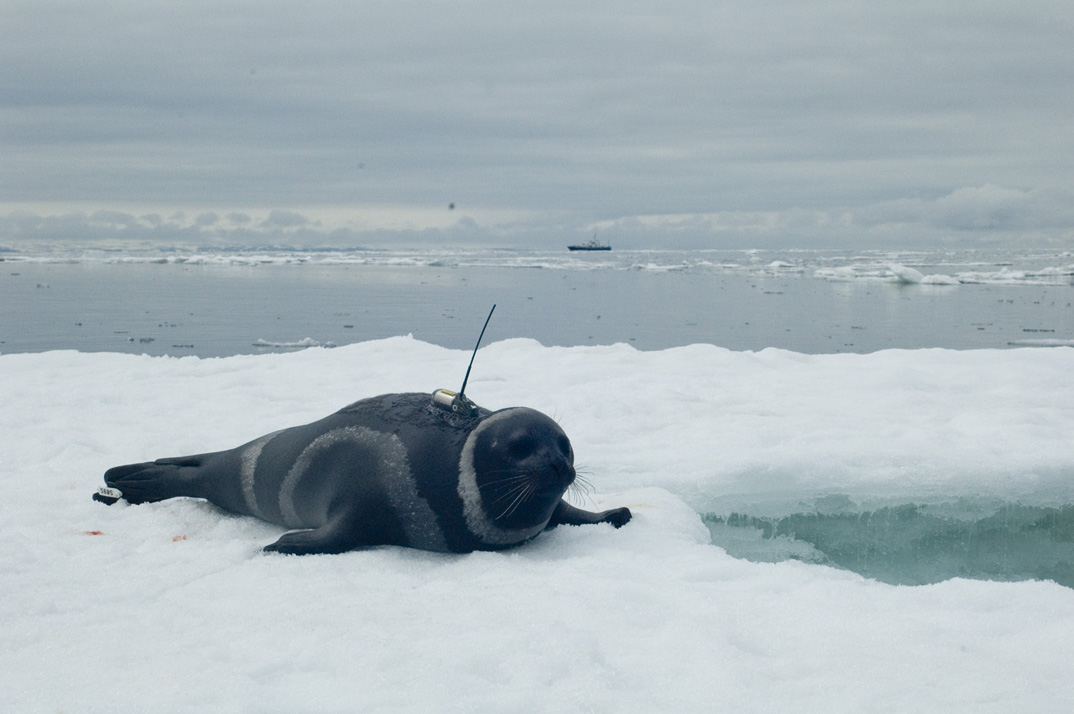Northern Bering Sea 2007
National Marine Mammal Laboratory Research Efforts on NBS 2007 cruise
![]()
 Four
species of ice-associated seals inhabit the Bering Sea: ribbon (Histriophoca
fasciata), ringed (Pusa hispida), bearded (Erignathus
barbatus), and spotted seals (Phoca largha). These
seals are key components of arctic marine ecosystems and they are
important resources for the Alaska Natives of northern and
western Alaska. The seals that live near shore have been studied
for many years but we know very little about the seals that
occupy the marginal and inner pack ice zone of the Bering Sea.
Four
species of ice-associated seals inhabit the Bering Sea: ribbon (Histriophoca
fasciata), ringed (Pusa hispida), bearded (Erignathus
barbatus), and spotted seals (Phoca largha). These
seals are key components of arctic marine ecosystems and they are
important resources for the Alaska Natives of northern and
western Alaska. The seals that live near shore have been studied
for many years but we know very little about the seals that
occupy the marginal and inner pack ice zone of the Bering Sea.
Ice extent in the Bering Sea has decreased in recent years and there are many questions about how seals will respond to changing sea ice conditions. For example: Will the seals move into new areas (possibly moving north to stay with the sea ice)? Will their usual prey move into different areas or be reduced in numbers, perhaps making it harder for seals to find food? Will the seals have to travel longer distances to reach their foraging grounds from their resting areas on the ice?
In order to answer some of these questions, we are going to have the seals collect data for us. Researchers from NOAA’s National Marine Mammal Laboratory will use small boats to reach ice floes occupied by seals. The seals will be captured using nets, and an instrument will be attached either to the seals’ back using quick-setting glue, or to their flipper like an earring. The instruments attached with glue will fall off with the animal’s next molt (when they lose their hair) which could be between 1 and 11 months. These instruments are called satellite-linked data recorders (SDRs), and they collect information that will be transmitted back to us by satellite and will provide information on:
| where the seals live throughout the seasons (even when the ice is gone), | |
| what the oceanographic conditions are around the seals (e.g., water temperature), | |
| how the seals forage (find food) and, | |
| how much time the seals
spend in and out of the water. |
 In
a related project we will also conduct helicopter- and ship-based
surveys of the pack ice to count seals and identify where they
are distributed. We will compare data collected by the different
projects of this expedition (fish, zooplankton, and physical
oceanography) with the data collected by the SDRs and the aerial
surveys to better understand the habitat selection of ice seals
in the pack ice ecosystem. This will improve our understanding of
these seals and help us to predict how changing sea-ice
conditions may affect them.
In
a related project we will also conduct helicopter- and ship-based
surveys of the pack ice to count seals and identify where they
are distributed. We will compare data collected by the different
projects of this expedition (fish, zooplankton, and physical
oceanography) with the data collected by the SDRs and the aerial
surveys to better understand the habitat selection of ice seals
in the pack ice ecosystem. This will improve our understanding of
these seals and help us to predict how changing sea-ice
conditions may affect them.